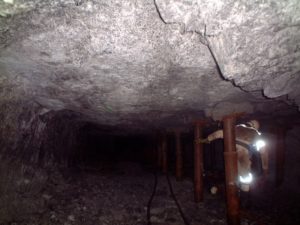
The study of faulting and rupture processes requires direct observations. In the Earth crust deep mines provide a unique opportunity for this purpose by giving access to the focal depth of earthquakes. To investigate the physics of earthquakes and link laboratory and seismological observations, the JAGUARS (Japanese-German Acoustic Emission Research in South Africa) Working Group was established. The JAGUARS project continuously monitored pico- and nanoseismic activity at 3.5km depth in Mponeng deep gold mine in the Republic of South Africa.
The deep gold mine is a unique natural laboratory to study kinematic and dynamic properties both of source and propagation of seismic events, fault properties as well as stress conditions. The seismic monitoring can provide direct observations of local instabilities in the rock mass induced by mine excavations and in existing geological structures such as dyke contacts or natural faults.
JAGUARS’ network was located 90m below the gold reef, where intensive mining was performed next to the Pink Green dyke. The major components of the network were 8 acoustic emission sensors and one three-component accelerometer. The sampling frequency of the acquisition system is 500 kHz and the total frequency range recorded is between 50Hz and 200 000Hz. The whole system worked in triggering mode.
In the time period end of May 2007 and beginning of April, 2009 almost 600,000 events were successfully recorded.
My tasks

- Creation and maintenance of the JAGUARS database
- Study of the self-similarity of earthquake rupture process in pico- and nanoscale (moment magnitude -4.0 to 0.0 or source size from cm- to m- scale). We analyzed static (seismic moment vs source radius) and dynamic (radiated energy vs seismic moment) as well as the Gutenberg Richter scaling relations. The results were published in BSSA and SRL (see references below) and presented at numerous meetings (AGU, SSA, DGG, EGU)
- Study of magnitude and time clustering of pico- and nanoearthquakes – cooperation with prof. Joern Davidsen, University of Calgary
- Study of shear/tensile faulting signatures – cooperation with prof. Yehuda Ben-Zion, University of Southern California
Publication list
This publication list contains articles with direct involvement of GFZ team. The comprehensive description of the experiment is presented in our most recent work:
- Plenkers, K., G. Manthei, and G. Kwiatek (2022). Underground In-situ Acoustic Emission in Studyof Rock Stability and Earthquake Physics. In: Grosse C. U., M. Ohtsu, D.G. Aggelis, and T. Shiotani (eds). Acoustic Emission Testing. Springer Tracts in Civil Engineering. Springer, Cham, DOI: 10.1007/978-3-030-67936-1_16. [ Article Page ]
Articles:
- Ziegler, M., Reiter, K., Heidbach, O., Zang, A., Kwiatek, G., Stromeyer, D., Dahm, T., Dresen, G. and G. Hofmann (2015). Mining induced stress transfer and its relation to a Mw1.9 seismic event in an ultra-deep South African gold mine, Pure. Appl. Geophys., DOI: 10.1007/s00024-015-1033-x. [ Article page ]
- Kozłowska, M., Orlecka-Sikora, B., Kwiatek, G., Boettcher, M. S. and G. Dresen (2014). Nanoseismicity and picoseismicity rate changes from static stress triggering caused by a Mw2.2 earthquake in Mponeng gold mine, South Africa, J. Geophys. Res. 120, DOI: 10.1002/2014JB011410. [ Article page ]
- Kwiatek, G. and Y. Ben-Zion (2013). Assessment of P and S wave energy radiated from very small shear-tensile seismic events in a deep South African mine. J. Geophys. Res. 118, 3630-3641, DOI: 10.1002/jgrb.50274. [ Article Page ]
- Davidsen, J., and G. Kwiatek (2013). Earthquake interevent time distribution for induced micro-, nano- and picoseismicity. Phys. Rev. Lett., 110, 068501, DOI: 10.1103/PhysRevLett.110.068501. [ Article Page ] [ Download full text ]
- Davidsen, J., Kwiatek, G., and G. Dresen (2012). No evidence of magnitude clustering in an aftershock sequence of nano- and picoseismicity. Phys. Rev. Lett., 108, 038501, DOI: 10.1103/PhysRevLett.108.038501. [ Article Page ] [ Download full text ]
- Kwiatek, G., Plenkers, K., and G. Dresen (2011). Source parameters of picoseismicity recorded at Mponeng deep gold mine, South Africa: Implications for scaling relations. Bull. Seismol. Soc. Am., 101(6): 2592-2608, DOI: 10.1785/0120110094. [ Article Page ] [ Download full text ]
- Plenkers, K., Schorlemmer, D., and G. Kwiatek (2011). On the probability of detecting picoseismicity. Bull. Seismol. Soc. Am., 101(6): 2579-2591, DOI: 10.1785/0120110017. [ Article Page ] [ Download full text ]
- Naoi, M., Nakatani, M., Yabe, Y., Kwiatek, G., Igarashi, T., and K. Plenkers. Twenty thousand aftershocks of a very small (M2) earthquake and their relations to the mainshock rupture and geological structures (2011). Bull. Seismol. Soc. Am., 101(5): 2399–2407, DOI: 10.1785/0120100346. [ Article Page ] [ Download full text ]
- Kwiatek, G., Plenkers, K., Nakatani, M., Yabe, Y., Dresen, G., and JAGUARS Research Group (2010). Frequency-magnitude characteristics down to magnitude −4.4 for induced seismicity recorded at Mponeng gold mine, South Africa. Bull. Seismol. Soc. Am., 100(3): 1167–1173, DOI: 10.1785/0120090277. [ Article Page ] [ Download full text ]
- Plenkers, K., Kwiatek, G., Nakatani, M., Dresen, G., and JAGUARS Research Group (2010). Observation of seismic events with frequencies f > 25 kHz at Mponeng deep gold mine, South Africa. Seism. Res. Lett., 81(3): 467–478, DOI: 10.1785/gssrl.81.3.467. [ Article Page ] [ Download full text ]